日記/Diary
「マダガスカルを学ぶ日」を開催しました
5月30日、マダガスカル出身のシスターBerthineがスクールに来てくださり、国際交流の機会となる「マダガスカルを学ぶ日」を開催しました。明るくて才能あふれるシスターBerthineは、母国の豊かな文化を楽しく心に残るかたちで紹介してくださいました。
当日は、シスターBerthineの伝統舞踊の披露から始まりました。水とお花を入れたペットボトルを頭にのせたまま優雅に踊る姿に、子どもたちも先生たちも思わず「わあ!」「すごいね!」と目を輝かせて見入っていました。
そのあとはマダガスカルのダンスを教えていただきました。シスターのリズムに合わせて、一つひとつのステップを楽しく覚えながら、みんなで元気いっぱいに踊りました。教室中に笑顔と笑い声があふれ、あたたかい雰囲気に包まれました。
前日には、シスターBerthineと、日本でモンテッソーリ教育40年以上のご経験を持つベテランのシスターたちが教室の飾りつけをしてくださいました。心を込めて作られた飾りが教室を彩り、マダガスカルの雰囲気たっぷりの居心地のよい空間ができあがりました。
シスターBerthineは、マダガスカルの自然や暮らしについてフランス語でわかりやすくお話ししてくださいました。シスターの一人が日本語と英語に通訳をしてくださって、みんなでしっかりと理解しながら楽しく聞くことができました。子どもたちは真剣に耳を傾け、質問にも元気よく答えていました。
そのあと、マダガスカルの代表的な動植物のぬりえに挑戦しました。バオバブの木やキツネザル、カメレオン、ラビナラ(旅人の木)、美しいランの花、赤い小鳥のフディ、雨の訪れを知らせる「カッコウローラー」という鳥など、色とりどりの世界を思い思いに表現しました。
そしてお待ちかねのおやつタイム。シスターBerthineが用意してくださったのは、マダガスカルの伝統的なおやつ「モフォガシー」。小麦粉・砂糖・牛乳を使った揚げ菓子で、外はカリッと中はふんわり、みんな大喜びでした。日本のシスターたちが準備してくださったお菓子も一緒に楽しみながら、和やかなティータイムとなりました。
イベントの最後は、子どもたちが書いた感謝のメッセージをプレゼントとしてシスターBerthineにお渡ししました。笑顔いっぱいの温かい時間となり、心に残る素敵な一日となりました。
シスターBerthine、そして日本のモンテッソーリの先生方、本当にありがとうございました。皆さんの温かさと情熱があふれる、忘れられない素敵な文化交流のひとときとなりました。
Learning About Madagascar
We were honored to welcome Sr. Berthine, a joyful and talented nun and teacher from Madagascar, who shared her country’s vibrant culture with us in a truly memorable way.
The day began with her captivating traditional dance performance, where she gracefully balanced a bottle filled with water and flowers on her head. Children and teachers watched in amazement, exclaiming “Wow!” and “Sugoi ne!” Afterward, Sr. Berthine taught everyone a fun Malagasy dance, step by step, and we danced together to cheerful music. The atmosphere was full of joy and laughter!
Before the event, the classroom was beautifully decorated the day before with the help of Sr. Berthine and our retired Japanese Montessori teachers—Sisters who each have more than four decades of teaching experience. Their thoughtful work helped create a warm and inviting space filled with the spirit of Madagascar.
Sr. Berthine then gave an interactive presentation about her homeland. She spoke in French, which was translated into Japanese by one of our Japanese Sisters, and English translation was given so everyone could understand and connect. Children listened with curiosity and proudly answered questions, showing how much they had learned.
We also had a creative coloring activity featuring the famous baobab trees, lemurs, chameleons, ravinala (traveler’s palm), orchids, Madagascar fody (a bright red bird), and the Cuckoo Roller, a unique bird known for predicting rain with its cry.
To top it off, Sr. Berthine prepared Mofogasy—a traditional Malagasy snack made of flour, sugar, and milk, deep-fried to perfection. Everyone loved it! We also enjoyed delicious treats from our Japanese Sisters during a joyful tea party.
As a special thank-you, the children prepared heartfelt messages, which were presented to Sr. Berthine as a gift after the event—bringing smiles and warmth to everyone’s hearts.
We are deeply grateful to Sr. Berthine and our beloved Japanese Montessori Sisters. Their passion, kindness, and dedication created another heartwarming cultural experience we will always cherish.
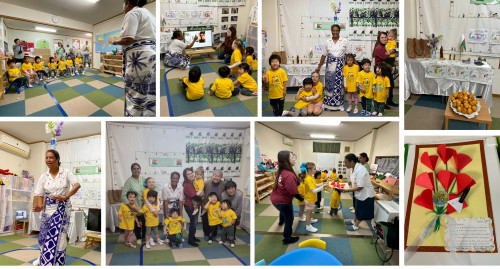
「パキスタンを学ぶ日」を開催しました
5月16日、子どもたちにとって大変貴重な国際交流の機会となる「パキスタンを学ぶ日」を開催しました。ご協力いただいたのは、パキスタン出身で現在日本で活動されている心あたたかな修道女、シスターEstherです。
イベントの前日、シスターEstherは、長年モンテッソーリ教育に携わってこられた経験豊富な日本人のモンテッソーリ・シスターたちと一緒に教室を飾りつけてくださいました。バロチスタン州、カイバル・パクトゥンクワ州、パンジャーブ州、シンド州というパキスタンの4つの州を表すカラフルな布で彩られた教室は、明るく温かなパキスタンの雰囲気に包まれました。
当日、シスターEstherは、パキスタンの文化、言語、服装、食べ物、そして伝統について素敵なプレゼンテーションをしてくださいました。さらに、伝統的なパキスタンのダンスも披露してくださり、みんなにステップを教えてくださいました。子どもたちも先生たちも一緒になって踊り、笑顔と笑い声であふれる時間となりました!
プレゼンテーションのあとはQ&Aタイム。先生と子どもたちがそれぞれ質問や答えを交わしました。子どもたちがどれだけたくさんのことを覚えて理解していたかが感じられ、とても嬉しく思いました。
続いて、特別なティーパーティーを開きました。シスターEstherが用意してくださったおいしいチャイは、子どもたちも楽しめるように、紅茶・ミルク・砂糖でやさしくアレンジされたものでした。年長の生徒が笑顔で「チャイティーいかがですか?」と声をかけてみんなにチャイをいれてくれました。
さらに、教室でパキスタン風のカレーとナンも楽しみ、本物の味を満喫しました。
感謝の気持ちを込めて、子どもたちは心を込めた「ありがとうメッセージ」を準備し、イベントの最後にシスターEstherにプレゼントしました。それはとても感動的で、あたたかい気持ちでいっぱいになりました。
シスターEsther、日本のモンテッソーリ・シスターの皆さま、そしてこの素晴らしい文化交流イベントを支えてくださったすべての方々に、心より感謝いたします。学びがあり、笑顔があふれ、国を超えたつながりを感じる、本当に素敵な一日になりました。
Learning About Pakistan
We were blessed with a wonderful opportunity to learn about the beautiful country of Pakistan with the help of Sr. Esther, a kind and passionate nun and teacher from Pakistan.
The day before the event, Sr. Esther, along with retired Japanese Montessori Sisters—experienced teachers with over four decades of Montessori work—decorated our classroom using colorful fabrics to represent the four provinces of Pakistan: Balochistan, Khyber Pakhtunkhwa, Punjab, and Sindh. The room was filled with vibrant colors and a warm Pakistani atmosphere.
On the day of the event, Sr. Esther gave a lovely presentation about Pakistani culture, language, clothing, food, and traditions. She also shared a traditional Pakistani dance with us, teaching the steps to everyone. Children and teachers joined in, dancing with smiles and laughter!
Following the presentation, we held a Q&A session, where both teachers and children asked and answered questions. It was a joyful moment to see how much the children remembered and understood about Pakistan!
We then gathered for a special tea party, featuring delicious chai tea prepared by Sr. Esther. It was a gentle version of the classic recipe made with black tea, milk, and sugar, so the children could enjoy it too. Our oldest student, who happily volunteered, served the tea with a big smile, kindly asking everyone, “Do you like some chai tea?”
We also enjoyed Pakistani-style curry and naan bread, bringing the taste of Pakistan to our classroom.
To show our gratitude, the children prepared heartfelt thank-you messages, which were presented to Sr. Esther as a gift after the event. It was a touching moment full of appreciation and joy.
We are truly grateful to Sr. Esther, the Japanese Montessori Sisters, and all who made this beautiful cultural event a success. It was a day filled with learning, joy, and connection — a celebration of friendship across borders.
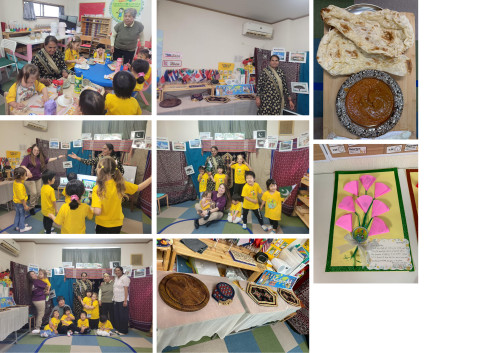
セントビンセントおよびグレナディーン諸島 ティーパーティーを開催しました
10月2日、モンテッソーリの文化の授業で、セントビンセントおよびグレナディーン諸島という美しい国について学びました。
生徒のお父さまがその国で生活して働いた経験があり、快く協力してくださってプレゼンテーションをしてくれました。スライドの写真を、まるで本物の先生のように自然で楽しさと魅力をたっぷり込めて説明してくださり、大人も子どもも思わず引き込まれてしまいました!
子どもたちは、国旗とその意味、有名な場所、著名な人物、伝統的な料理などについて学びました。プレゼンテーションの後には楽しいQ&Aセッションがあり、子どもたちはたくさんの質問をして理解を深めることができました。
子どもたちは授業の前日に「I Love Saint Vincent and the Grenadines Country」という歌に合わせてダンスを練習し、特別なパフォーマンスの準備をしていました。当日はサークルタイム中にそのダンスをもう一度練習しましたが、今回はご両親も参加してさらに盛り上がりました!
授業の最後は楽しいティーパーティーで締めくくり、学びと楽しさ、そして素晴らしい思い出に満ちた素敵な体験となりました。
On October 2nd, we had an amazing Montessori Culture lesson where we explored the beautiful country of Saint Vincent and the Grenadines.
One of our student’s dads, who had lived and worked there, kindly volunteered to give a lively presentation. He explained photos on the slides in such a fun and engaging way that both the kids and adults were captivated-like a natural teacher!
The children learned about the country’s flag and its meaning, along with famous landmarks, notable people, traditional foods, and much more.
After his presentation, we had a fun Q&A session where the kids asked great questions and deepened their understanding.
The day before, children practiced a dance to the song “I Love Saint Vincent and the Grenadines Country” for a special performance. On the day of the lesson, we practiced the dance again during circle time, but this time with the parents joining in, making it even more exciting!
We ended the day with a delightful tea party, making it a wonderful experience filled with learning, fun, and great memories for everyone involved.
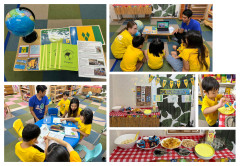
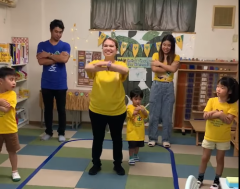
マレーシア ティーパーティを開催しました
8月29日、とても素敵なマレーシア ティーパーティーを開催しました。
マレーシアに住んでいたことのある生徒のお母さまが快く協力してくださり、マレーシアの文化や名所、有名な食べ物を私たちに共有してくれました。
また、ティーパーティーで子供たちが楽しめるおいしいマレーシアのお菓子も持ってきてくださいました。
子どもたちからの特別な感謝の気持ちとして、1週間練習したマレーシアの民謡「Rasa Sayang」を振り付け付きで披露しました。
パーティーは、初めから終わりまで楽しさと文化の触れ合いがいっぱいで、参加した全員は素晴らしい思い出を作ることができました。
On August 29th, we hosted a wonderful Malaysian Culture and Tea Party.
One of our student’s mothers, who used to live in Malaysia, kindly volunteered to share her knowledge of Malaysian culture, landmarks, and famous foods.
She also brought along some delicious Malaysian snacks for the children to enjoy during our tea party.
As a special thank you, the children performed the Malaysian folk song "Rasa Sayang," complete with a choreographed dance they had practiced for a week.
The whole event was filled with joy and cultural exchange, creating wonderful memories for everyone involved.
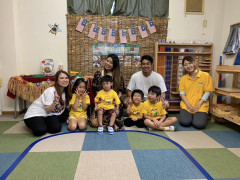
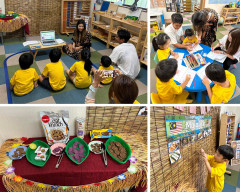

フィリピン式ティーパーティーを開催しました
パンパンガの豊かな文化を知る!
横浜からDhize先生がいらしてくれました。3時間近くかけて来られたにもかかわらず、元気いっぱいのディズ先生は、故郷の文化を子どもたちに教えてくれました。
子どもたちはパンパンガのおいしい食べ物について学び、心のこもった歌「アティン・クー・プン・シンギング」を歌い、ゲームや "バロ・アット・サヤ "と呼ばれるカパンパンガの伝統的な服の絵を描いて楽しみました。
一日の締めくくりに、ディズ先生がおいしいチョコレートドリンク、スカイフレークのクリームサンド、グラハムクラッカーをごちそうしてくれました。
笑い、学び、そして忘れられない思い出でいっぱいの一日でした!
〈楽しい豆知識〉
1. アティン・クー・プン・シンギングはパンパンガ州が発祥。この歌は、母親から譲り受けた大切な指輪を失ったことを嘆く人の物語を歌っている。タイトルは英語で「I Have a Ring」と訳される。
2. カパンパンガン語は、パンパンガ州とタルラック南部で主に話されている言語である。
3. バロ・アット・サヤ(ブラウスとスカート)は、フィリピンの女性が着用する伝統的なドレスアンサンブルである。フィリピンの民族衣装であり、先植民地時代のフィリピン先住民の服装と植民地時代のスペインの服装の両方の要素が組み合わされている。
Discovering Pampanga’s Rich Culture!
We had a special visitor, Teacher Dhize, who came all the way from Yokohama.
Even though she travelled for nearly 3 hours, she was full of energy to share her hometown’s culture with us.
We learned about Pampanga’s yummy foods, sang the heartfelt song “Atin Ku Pung Singing,” and had a blast playing games and drawing pictures of traditional Kapampangan clothes, called “Baro at Saya.” To cap off the day, Teacher Dhize treated us to tasty chocolate drinks, Skyflakes creamy sandwiches and Graham crackers. It was a day filled with laughter, learning, and unforgettable memories!
As a fun trivia,
1. “Atin Ku Pung Singsing” originates from the province of Pampanga. The song tells the story of someone lamenting the loss of a precious ring that was inherited from their mother. The title translates to “I Have a Ring” in English.
2.Kapampangan is the main language spoken in the province of Pampanga and in southern Tarlac.
3. The baro at saya (literally "blouse and skirt") is a traditional dress ensemble worn by women in the Philippines. It is a national dress of the Philippines and combines elements from both the precolonial native Filipino and colonial Spanish clothing styles.


